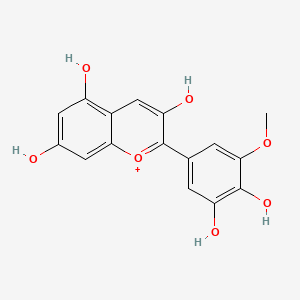| Authors | Title | Published | Journal | PubMed Link |
|---|---|---|---|---|
| Harb J et al. | Changes in polyphenols and expression levels of related genes in 'Duke' blueberries stored under high CO2 levels. | 2014 | J. Agric. Food Chem. | pmid:24999801 |
| Soubeyrand E et al. | Nitrogen supply affects anthocyanin biosynthetic and regulatory genes in grapevine cv. Cabernet-Sauvignon berries. | 2014 | Phytochemistry | pmid:24735825 |
| Sun LL et al. | Composition and antioxidant activity of the anthocyanins of the fruit of Berberis heteropoda Schrenk. | 2014 | Molecules | pmid:25415473 |
| Vodopivec BM et al. | Differences in the structure of anthocyanins from the two amphibious plants, Lobelia cardinalis and Nesaea crassicaulis. | 2013 | Nat. Prod. Res. | pmid:22694738 |
| Chauthe SK et al. | Quantitative NMR: an applicable method for quantitative analysis of medicinal plant extracts and herbal products. | 2012 Nov-Dec | Phytochem Anal | pmid:22707000 |
| Yoshimura Y et al. | Visualization of anthocyanin species in rabbiteye blueberry Vaccinium ashei by matrix-assisted laser desorption/ionization imaging mass spectrometry. | 2012 | Anal Bioanal Chem | pmid:22399120 |
| Romera-Fernández M et al. | Feasibility study of FT-MIR spectroscopy and PLS-R for the fast determination of anthocyanins in wine. | 2012 | Talanta | pmid:22265503 |
| Dastmalchi K et al. | Edible Myrciaria vexator fruits: bioactive phenolics for potential COPD therapy. | 2012 | Bioorg. Med. Chem. | pmid:22739086 |
| Kamonpatana K et al. | Susceptibility of anthocyanins to ex vivo degradation in human saliva. | 2012 | Food Chem | pmid:22868153 |
| Veskoukis AS et al. | The antioxidant effects of a polyphenol-rich grape pomace extract in vitro do not correspond in vivo using exercise as an oxidant stimulus. | 2012 | Oxid Med Cell Longev | pmid:22693650 |
Petunidin
Petunidin is a lipid of Polyketides (PK) class. Petunidin is associated with abnormalities such as Vitamin A Deficiency, Night Blindness, Blind Vision, Chronic Disease and Heart Diseases. The involved functions are known as Drug Interactions, selective breeding, Signal Transduction, Protective Agents and Evolution. Petunidin often locates in Membrane, Body tissue, Gastrointestinal tract structure, Blood and Hepatic. The associated genes with Petunidin are TP53 gene, Genome and Genome, Human. The related lipids are Steroids and Total cholesterol. The related experimental models are Knock-out, Disease model and Animal Disease Models.
Cross Reference
Introduction
To understand associated biological information of Petunidin, we collected biological information of abnormalities, associated pathways, cellular/molecular locations, biological functions, related genes/proteins, lipids and common seen animal/experimental models with organized paragraphs from literatures.
What diseases are associated with Petunidin?
Petunidin is suspected in Chronic Disease, Obesity, Diabetes Mellitus, Non-Insulin-Dependent, Vitamin A Deficiency, Night Blindness, Blind Vision and other diseases in descending order of the highest number of associated sentences.
Related references are mostly published in these journals:
| Disease | Cross reference | Weighted score | Related literature |
|---|
No disease MeSH terms mapped to the current reference collection.
PubChem Associated disorders and diseases
What pathways are associated with Petunidin
There are no associated biomedical information in the current reference collection.
PubChem Biomolecular Interactions and Pathways
Link to PubChem Biomolecular Interactions and PathwaysWhat cellular locations are associated with Petunidin?
Visualization in cellular structure
Associated locations are in red color. Not associated locations are in black.
Related references are published most in these journals:
| Location | Cross reference | Weighted score | Related literatures |
|---|
What functions are associated with Petunidin?
Related references are published most in these journals:
| Function | Cross reference | Weighted score | Related literatures |
|---|
What lipids are associated with Petunidin?
Related references are published most in these journals:
| Lipid concept | Cross reference | Weighted score | Related literatures |
|---|
What genes are associated with Petunidin?
Related references are published most in these journals:
| Gene | Cross reference | Weighted score | Related literatures |
|---|
What common seen animal models are associated with Petunidin?
Knock-out
Knock-out are used in the study 'How can research on plants contribute to promoting human health?' (Martin C et al., 2011).
Disease model
Disease model are used in the study 'How can research on plants contribute to promoting human health?' (Martin C et al., 2011).
Animal Disease Models
Animal Disease Models are used in the study 'How can research on plants contribute to promoting human health?' (Martin C et al., 2011).
Related references are published most in these journals:
| Model | Cross reference | Weighted score | Related literatures |
|---|
